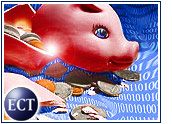Here’s a neat party trick. Make a list of the profitable or nearlyprofitable e-commerce companies you know about. Then circle all the e-tailcompanies — the ones that sell goods directly to consumers.
If your list is anything like mine, there is a distinct lack ofcircles. No circles, no large e-tailers in the black.
My list includes profitable firms like Yahoo! and eBay and almost-there entrieslike Travelocity. E*Trade eked out a profit in the most recent quarter.And the Internet job sites — Monster.com and HotJobs.com — are making money,too. In fact, they’re running Super Bowl ads for the second straight year.
E-tailers, it’s time to start worrying.
All Sectors Reporting
Now, I know some e-tailers are closing in on profitability, while othersare already profitable in certain segments of their business or in certainregions — such as Amazon’s bookstore or Kozmo’s New York City operations.
But that’s not the same as being bottom-line profitable right now or withinthe next quarter or two. At some point, the question has to be asked: Is thee-tail model inherently flawed?
The answer is probably yes and no, with a little uncertainty added to the mix because many e-tailers didn’t think much about profits for the better part of two years.
Ship Sliding Away
The flaws holding e-tail back are easy to spot, especially when e-tailers are contrasted with profitable companies.
While Yahoo! is a special case — since so much of its income derivesfrom advertising — the company also struts its stuff on the e-commerce side.But Yahoo! doesn’t have to deal with fulfilling orders and shipping products tobuyers.
Neither, for that matter, does eBay. The company simply enables thetransactions; the hassles are handled by buyers and sellers. And, ofcourse, stock trading, travel and job search sites all deal incommodities that don’t require a UPS truck to show up at your house.
Can Market Share Mint Money?
Scanning the profit landscape also reveals that except for e-tail, most othere-commerce subsectors are present. Travelocity is close to becomingtravel’s representative in the profit club, for instance.
So where is puree-tail’s representative? Shouldn’t one company be a strong enough swimmer toget its head above water?
Of course, many e-tailers drenched themselves in red ink by buying customers earlyin their lives. Now they have market share and site traffic galore toshow for it. But the tough part comes next — boosting margins enough to maketheir business pay.
That’s going to mean higher prices and lower costs, along with bettercustomer service. It’s a tall order — one that I’m not suree-tailers have proven themselves worthy of filling just yet.
Small Fries Stayin’ Alive
The better news is that many smaller e-tailers have managed to make a profit by investing only their own money and by growing slowly, largely throughword of mouth. So it’s simply a matter of taking the formulathat’s worked for mom-and-pop Web merchants and translating it to a grander scale.
The question is whether that translation can be accomplished by companiesalready paddling upstream against the torrent of cash they burned to grabeyeballs and attention.
Some of the bigger fish surely will overcome the tide, but it may be even easier forsmaller e-tailers to continue growing their business organically — just letting it happen, even if it takes some time.
Who knows? Two years from now, we may be making a list of profitablee-tailers. And it may even be lengthy. But will we recognize any of those names from the early days of e-commerce? I wouldn’t bet on it.
What do you think? Let’s talk about it.
























































Social Media
See all Social Media